
The National Union Convention (also known as the Loyalist Convention, the Southern Loyalist Convention, the National Loyalists' Loyal Union Convention, or the Arm-In-Arm Convention) was held on August 14-16, 1866, in Philadelphia, Pennsylvania. [1]

The National Union Convention (also known as the Loyalist Convention, the Southern Loyalist Convention, the National Loyalists' Loyal Union Convention, or the Arm-In-Arm Convention) was held on August 14-16, 1866, in Philadelphia, Pennsylvania. [1]
The convention was called in Philadelphia before the midterm elections of 1866, in an attempt to encourage political support for US President Andrew Johnson, who was under attack by both moderate and Radical Republicans. Johnson's friends tried to rally support for his lenient pro-South Reconstruction policies. Some hoped to create a new political party, but that goal was not realized. [2] For their part, Republican-aligned newspapers called it the Rebel–Johnson convention, insinuating Johnson's true loyalty was to the Confederacy. [3]
Delegates gathered at a hastily-built temporary structure that was designed to accommodate the several thousand people expected to attend. Formally called "the Wigwam," the immense edifice was on Girard Avenue, between 19th and 20th Streets, across from Philadelphia's Girard College. [2]
The convention voted on a resolution supporting black suffrage. Governor Arthur I. Boreman argued against it as "we did not come here to commit suicide" and that passing the resolution would have them "damned to all eternity". Frederick Douglass, attending the convention despite pleas from Oliver P. Morton, was one of two black delegates to the convention and argued for passing the resolution. [4]
About 7000 prominent politicians and activists attended the convention. At its opening, representatives from Massachusetts (General Darius Nash Couch) and South Carolina (Governor James Lawrence Orr) paraded arm-in-arm to symbolize national reconciliation and social equity. The convention was called to order by US Postmaster General Alexander Randall. General (and former New York Governor and Senator) John Adams Dix served as the temporary chairman and Wisconsin Senator James R. Doolittle served as permanent convention president.
In the end, the convention was not successful in unifying the country behind Johnson. He launched a speaking tour (known as the "Swing Around the Circle") hoping to regain public and political support. On the speaking tour, Johnson at times attacked his Republican opponents with crude and abusive language and on several occasions appeared to have had too much to drink. Ultimately, the tour was a disaster for Johnson and emboldened Congress to override him and to impeach him in 1868. [2]
Notable attendees of the National Union Convention include:
Clement Vallandigham, a copperhead from Ohio, was elected to the convention but withdrew to avoid disturbing the harmony of the convention.

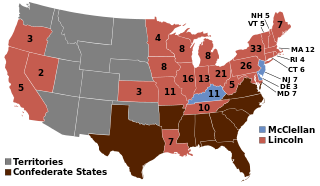
The 1864 United States presidential election was the 20th quadrennial presidential election. It was held on Tuesday, November 8, 1864. Near the end of the American Civil War, incumbent President Abraham Lincoln of the National Union Party easily defeated the Democratic nominee, former General George B. McClellan, by a wide margin of 212–21 in the electoral college, with 55% of the popular vote. For the election, the Republican Party and some Democrats created the National Union Party, especially to attract War Democrats.
The Radical Republicans were a faction within the Republican Party originating from the party's founding in 1854—some six years before the Civil War—until the Compromise of 1877, which effectively ended Reconstruction. They called themselves "Radicals" because of their goal of immediate, complete, and permanent eradication of slavery in the United States. They were opposed during the war by the Moderate Republicans, and by the Democratic Party. Radicals led efforts after the war to establish civil rights for former slaves and fully implement emancipation. After unsuccessful measures in 1866 resulted in violence against former slaves in the rebel states, Radicals pushed the Fourteenth Amendment for statutory protections through Congress. They opposed allowing ex-Confederate officers to retake political power in the Southern U.S., and emphasized equality, civil rights and voting rights for the "freedmen", i.e., former slaves who had been freed during or after the Civil War by the Emancipation Proclamation and the Thirteenth Amendment.
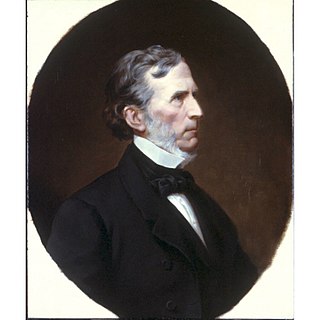
The Joint Committee on Reconstruction, also known as the Joint Committee of Fifteen, was a joint committee of the 39th United States Congress that played a major role in Reconstruction in the wake of the American Civil War. It was created to "inquire into the condition of the States which formed the so-called Confederate States of America, and report whether they, or any of them, are entitled to be represented in either house of Congress.”

The 1908 Republican National Convention was held in Chicago Coliseum, Chicago, Illinois on June 16 to June 19, 1908. It convened to nominate successors to President Theodore Roosevelt and Vice President Charles W. Fairbanks.
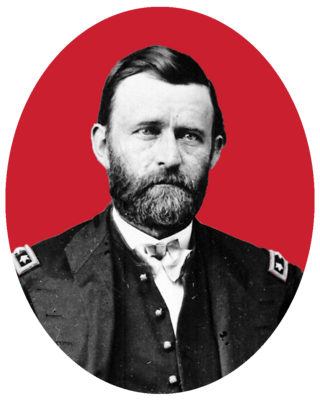
The 1868 Republican National Convention of the Republican Party of the United States was held in Crosby's Opera House, Chicago, Cook County, Illinois, on May 20 to May 21, 1868. Ulysses S. Grant won the election and became the 18th president of the United States.
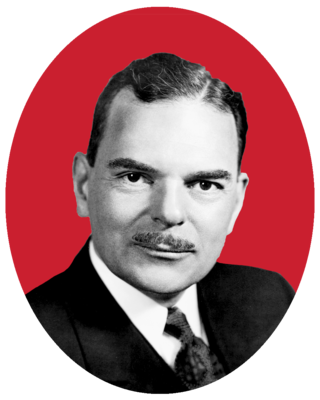
The 1948 Republican National Convention was held at the Municipal Auditorium, in Philadelphia, Pennsylvania, from June 21 to 25, 1948.
The 1868 Democratic National Convention was held at the Tammany Hall headquarters building in New York City between July 4, and July 9, 1868. The first Democratic convention after the conclusion of the American Civil War, the convention was notable for the return of Democratic Party politicians from the Southern United States.

The 1856 Republican National Convention was a presidential nominating convention that met from June 17 to June 19, 1856, at Musical Fund Hall at 808 Locust Street in Philadelphia, Pennsylvania. It was the first national nominating convention of the Republican Party, founded two years earlier in 1854. It was held to nominate the party's candidates for president and vice president in the 1856 election. The convention selected former John C. Frémont, a United States Senator from California, for president, and former Senator William L. Dayton of New Jersey for vice president. The convention also appointed members of the newly established Republican National Committee.

Peter Godwin Van Winkle was an American lawyer, businessman and politician. For many years a leading officer of the Northwestern Virginia Railroad, he became one of the founders of West Virginia and a United States senator.
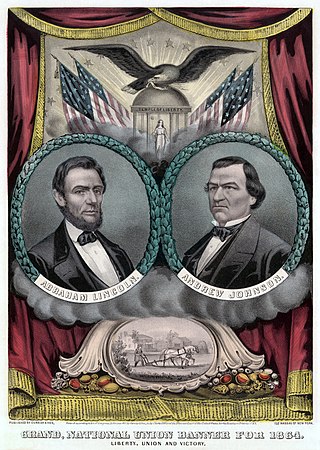
The National Union Party was the name used by the Republican Party and elements of other parties for the national ticket in the 1864 presidential election during the Civil War. Most state Republican parties did not change their name. The name was used to attract War Democrats, border state voters, and Unconditional Unionist, and Unionist Party members who might otherwise have not voted for Republicans. The National Union Party nominated incumbent Republican President Abraham Lincoln of Illinois and Democrat Andrew Johnson of Tennessee for Vice President. They won the Electoral College 212–21.

The 1888 Republican National Convention was a presidential nominating convention held at the Auditorium Building in Chicago, Illinois, on June 19–25, 1888. It resulted in the nomination of former Senator Benjamin Harrison of Indiana for president and Levi P. Morton of New York, a former Representative and Minister to France, for vice president. During the convention, Frederick Douglass was invited to speak and became the first African-American to have his name put forward for a presidential nomination in a major party's roll call vote; he received one vote from Kentucky on the fourth ballot.
War Democrats in American politics of the 1860s were members of the Democratic Party who supported the Union and rejected the policies of the Copperheads. The War Democrats demanded a more aggressive policy toward the Confederacy and supported the policies of Republican President Abraham Lincoln when the American Civil War broke out a few months after his victory in the 1860 presidential election.